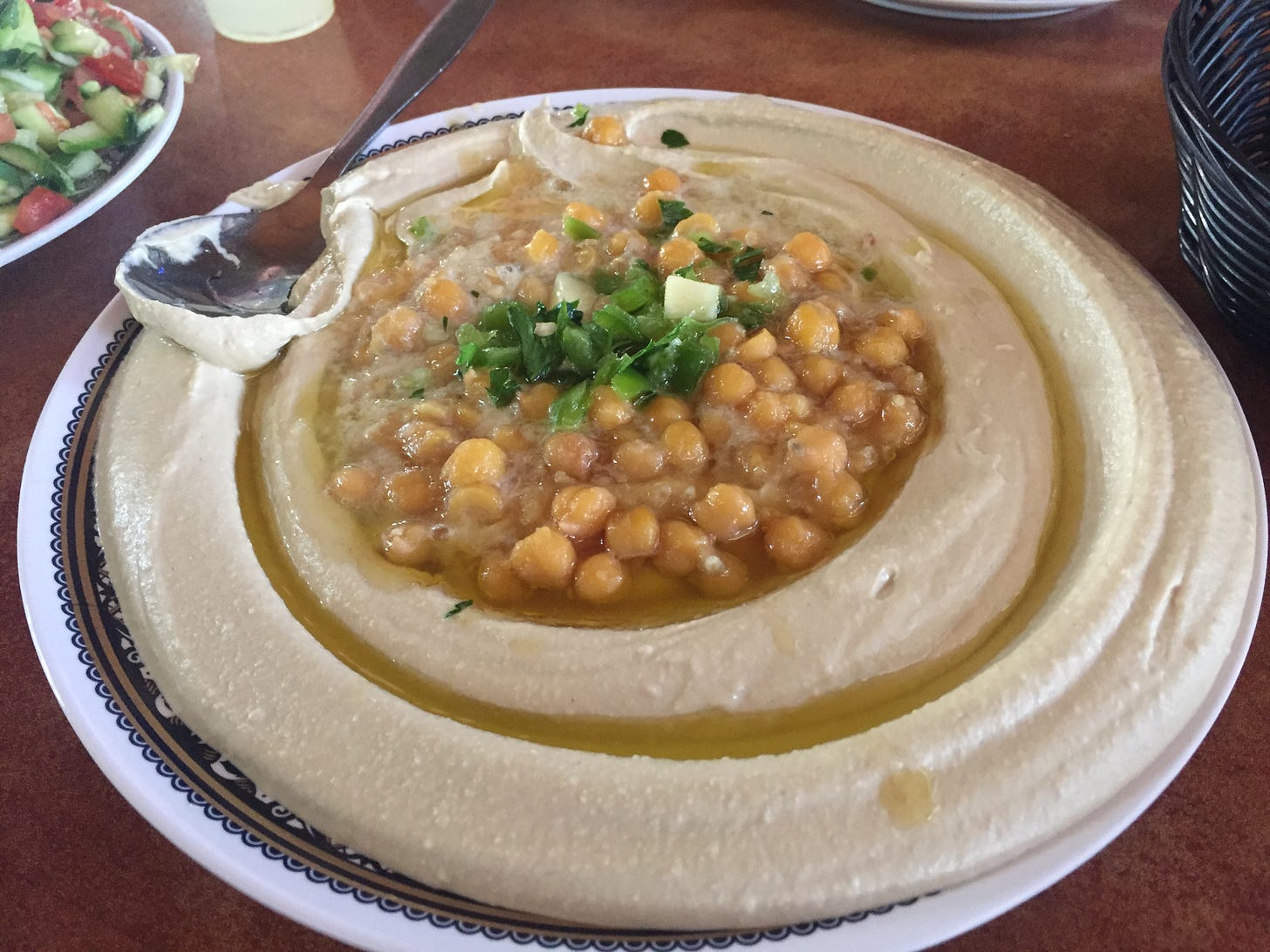Today’s topic might seem simple and/or basic: hummus. But don’t be fooled, there are layers and layers to the hummus story, each richer and more delicious than the last, so, without further ado, let’s dig in! Hummus is both Hebrew and Arabic for chickpea, a legume that has been cultivated for millennia. It is one of the most widely eaten foods in the Middle East, and, in recent decades, it has gone global. Today it can be easily found in supermarkets, cafes, and Instagram reels (seriously, crazy numbers of views for bowls of hummus!) all over the world. However, not all hummus is created equal, and what you pick up at your local grocer is not remotely the same as what we are talking about here.
We have many wonderful books in our home, but the one that most often gets picked off the shelves by guests (and us!) is a gem called On the Hummus Route: A Journey Between Cities, People, and Dreams. It traces an imaginary route from Cairo to Damascus, with stops in Gaza, Jaffa, Tel Aviv, Jerusalem, Nazareth, Acre, and Beirut. Each of its 408 pages are beautifully filled with essays, photos, and recipes, all paying tribute to hummus.
As much as anyone might like to assert the superiority of “their” hummus, no monopoly on excellence exists. There is unbelievably good hummus across the entire “Hummus Route.” In Israel, hummus is more than a snack, spread, or dip. It’s a revered, almost spiritual, part of the culinary day. It's common to hear someone say, only half-joking, “You don't eat hummus. You go to hummus.” In Israel, hummusiyahs (hummus shops) range from hole-in-the-wall neighborhood spots to legendary institutions known for particular styles and secret recipes. There is fierce debate about where to find the best hummus (feel free to DM for my top picks), whether you should go smooth or chunky, warm or chilled, topped (with fava beans, pine nuts, etc), or left completely pure (I’m firmly in the smooth, warm with lots of olive oil, purist camp).
But what makes Israeli hummus distinct isn’t only the recipe (though that’s part of it); it’s also the ritual and reverence. A perfect plate of hummus is made fresh, served warm, and swirled in a shallow bowl with a pool of golden olive oil, sometimes a dash of paprika or parsley, and always with fresh pita. You don’t dip. You scoop. You wipe. You clear the plate. Israelis eat hummus as a meal, not a side. It is common to go out with friends and share a single, beautiful bowl, each person claiming their quadrant, scooping from the outer ring inward like a dance. It’s an experience of both nourishment and community.
Before visiting Israel, I thought I understood what hummus was; I knew where to find it in Whole Foods and typically had an 8oz tub of it in the refrigerator. Then, in Jaffa, I had my first plate of real hummus—fresh, warm, silky, smooth, and like nothing I’d ever eaten. It was a revelation, just like in the Pixar classic Ratatouille, when Remy the Rat eats cheese after being struck by lightning. Since then, I have worked hard to recreate that magic in our own kitchen. It will likely take years (maybe generations?) to hit the level of skill that is commonplace in any decent shop in across the Hummus Route. But perfection isn’t the goal. The aim is to infuse love, care, and the very best intentions when making deeply delicious and nutritious food for family and friends.
So yes, today’s post is ostensibly about hummus, but really, it’s about how a simple and ancient staple can become something transcendent when it's made with passion, rooted in tradition, and shared with others.
And friends, that’s a wrap on post #9, only 2,491 to go. See you tomorrow with more from Hopefully Beneficial. Shalom and let’s keep going!





It's surprising how much difference there is given how few ingredients go into it.
Yum! 💙